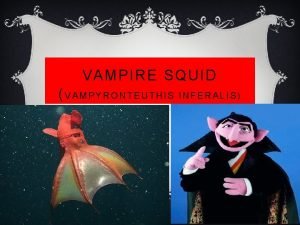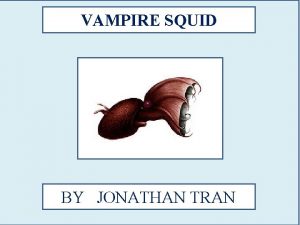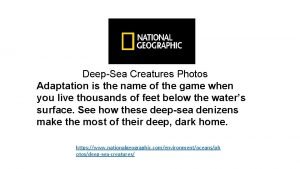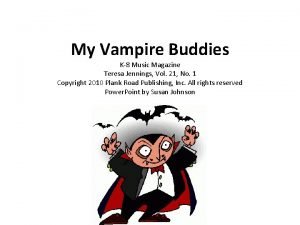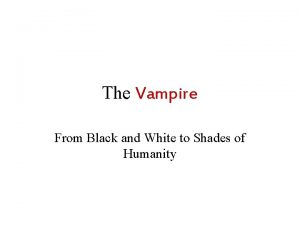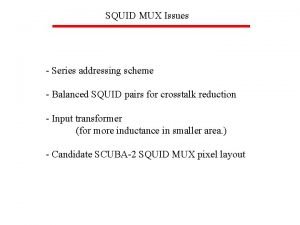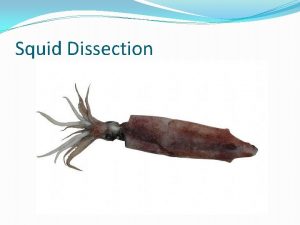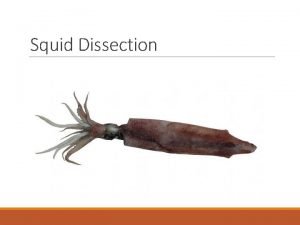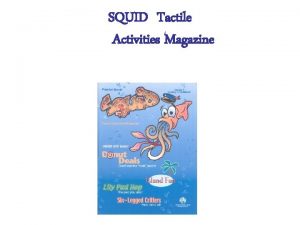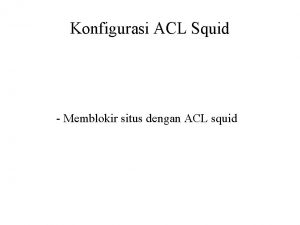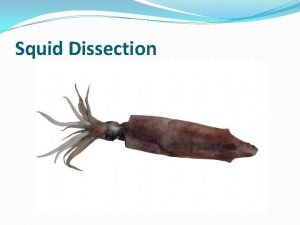VAMPIRE SQUID VAMPYRONTEUTHIS INFERALIS VAMPIRE SQUID FROM HELL











- Slides: 11

VAMPIRE SQUID (VAMPYRONTEUTHIS INFERALIS)

VAMPIRE SQUID FROM HELL v Vampire squid are named for their blue eyes, reddish brown skin, and webbing between their arms that looks like a cape. v It is a small creature, growing to only about six inches in length. v is a unique member of the cephalopod family in that it shares similarities with both squid and octopuses having 8 arms lined with a single row of suction cups and rows of soft, fleshy spines known as cirri. They lack the ink sacs and do not have the muscles that control color change that true squids have. v They are covered with light producing organs called photophores that give it bioluminescence.


SURVIVAL v When the photophores are off, the squid is completely invisible in the dark waters where it lives. v Creates a lightshow of complex patterns that can be used to disorient predators and attract prey. v When threatened, the vampire squid can flip its webbing completely over its body to protect itself from predators. This "pumpkin" or "pineapple" posture displays menacing-looking soft spines as well as protects and completely covers its eyes. v It doesn’t have an ink sac to squirt like most cephalopods do but it has its own goo squirts sticky, bioluminescent mucus from the tips of its arms which can stay lit up for 10 minutes, dazing and dazzling the predator while the vampire disappears into the shadows.


ECOSYSTEM v The vampire squid is a deep-sea cephalopod, thought to reside at aphotic (lightless) depths from (3, 000 feet) or more in a area known as the (OMZ) Oxygen Minimum zone. v In order to survive in these depths the squid has adapted so that its metabolic rate is the lowest and can transport more oxygen rich blood faster than all other cephalopods. v Is the only cephalopod that can live in such deep and low oxygen depths

FEEDING BEHAVIOR v It was thought that these animals were carnivorous as the name would suggest but… v Instead, the nightmarishly named species browses on "marine snow"—dead plankton, algae, fecal matter, goo, shells shed by tiny crustaceans, and other detritus. v The squid gather the food particles using two long, hairlined filaments before wrapping the bits into meal-size mucus balls,

REPRODUCTION v Vampire Squid reproduce by the males depositing sperm into the sac of the female. She will deposit fewer eggs than other species and they are also larger in size. The females may store the sperm though for several weeks before they allow it to fertilize the eggs. She will stay in the general area of these deposited eggs until they are ready to hatch. This can take about 13 months. v The females will die soon after their offspring are born. They don’t need to feed for the first few weeks of life. Instead they have an internal type of yolk that they are able to get nutritional value from.

HUMAN IMPACT v "They are threatened by ocean warming, decreasing oxygen, pollution, overfishing, industrialization, and dozens of other changes taking place in the deep, " said Bruce Robison, of the Monterey Bay Aquarium Research Institute

TURNING INSIDE OUT v http: //www. youtube. com/watch? v=IWAnli. Nc 6 wk&hd=1

FUN FACTS v Have the largest eyes relative to body size of any animal; although only six inches in size, they have globular eyeballs about the size of a large dog v Have two ivory white, powerful beak-like jaws v Large fins at the top of its body (resembling ears) are their primary means of propulsion v Have a very gelatinous form resembling a jellyfish v Color ranges from jet black to red
 Vampire squid from hell
Vampire squid from hell What is hell
What is hell Chapter 25 section 1 flatworms answer key
Chapter 25 section 1 flatworms answer key Interesting facts about the vampire squid
Interesting facts about the vampire squid Nightmarish fangtooth
Nightmarish fangtooth Give up all hope ye who enter here
Give up all hope ye who enter here Richard trenton chase iq
Richard trenton chase iq Vampire bat enemies
Vampire bat enemies Vampire buddies
Vampire buddies Vampire black and white
Vampire black and white Treaty of versailles vampire cartoon
Treaty of versailles vampire cartoon Vampire archetypes
Vampire archetypes
